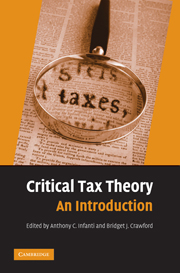Book contents
- Frontmatter
- Contents
- List of Illustrations
- List of Tables
- List of Contributors
- List of Common Abbreviations
- Introduction
- CHAPTER 1 FOUNDATIONS OF CRITICAL TAX THEORY
- CHAPTER 2 HISTORICAL PERSPECTIVES ON TAXATION
- CHAPTER 3 THE GOALS OF TAX POLICY
- CHAPTER 4 CRITICAL TAX THEORY MEETS PRACTICE
- CHAPTER 5 RACE AND TAXATION
- CHAPTER 6 GENDER AND TAXATION
- CHAPTER 7 SEXUAL ORIENTATION AND TAXATION
- CHAPTER 8 THE FAMILY AND TAXATION
- CHAPTER 9 CLASS AND TAXATION
- Women, Poverty, and the Tax Code: A Tale of Theory and Practice
- The Working Poor Are Paying for Government Benefits: Fixing the Hole in the Anti-Poverty Purse
- Welfare by Any Other Name: Tax Transfers and the EITC
- Race, Class, and the Internal Revenue Code: A Class-Based Analysis of A Black Critique of the Internal Revenue Code
- CHAPTER 10 DISABILITY AND TAXATION
- CHAPTER 11 GLOBAL CRITICAL PERSPECTIVES ON TAXATION
- CHAPTER 12 CRITICAL PERSPECTIVES ON CRITICAL TAX THEORY
- Index
Welfare by Any Other Name: Tax Transfers and the EITC
Published online by Cambridge University Press: 04 August 2010
- Frontmatter
- Contents
- List of Illustrations
- List of Tables
- List of Contributors
- List of Common Abbreviations
- Introduction
- CHAPTER 1 FOUNDATIONS OF CRITICAL TAX THEORY
- CHAPTER 2 HISTORICAL PERSPECTIVES ON TAXATION
- CHAPTER 3 THE GOALS OF TAX POLICY
- CHAPTER 4 CRITICAL TAX THEORY MEETS PRACTICE
- CHAPTER 5 RACE AND TAXATION
- CHAPTER 6 GENDER AND TAXATION
- CHAPTER 7 SEXUAL ORIENTATION AND TAXATION
- CHAPTER 8 THE FAMILY AND TAXATION
- CHAPTER 9 CLASS AND TAXATION
- Women, Poverty, and the Tax Code: A Tale of Theory and Practice
- The Working Poor Are Paying for Government Benefits: Fixing the Hole in the Anti-Poverty Purse
- Welfare by Any Other Name: Tax Transfers and the EITC
- Race, Class, and the Internal Revenue Code: A Class-Based Analysis of A Black Critique of the Internal Revenue Code
- CHAPTER 10 DISABILITY AND TAXATION
- CHAPTER 11 GLOBAL CRITICAL PERSPECTIVES ON TAXATION
- CHAPTER 12 CRITICAL PERSPECTIVES ON CRITICAL TAX THEORY
- Index
Summary
What exactly are we trying to accomplish by delivering social welfare benefits through the tax system? This article will explore this systemic question, and pose two further questions. First, what and who are we targeting when we advocate tax-transfer programs like the [earned income tax credit (EITC)]? And, second, are our current efforts effectively assisting the targeted beneficiaries? In addition, this article will discuss the current political and administrative state of the EITC, and recommend several ways in which the EITC, already the largest anti-poverty program in the United States, can further expand its reach and efficacy.
QUESTION #1: WHAT EXACTLY ARE WE TRYING TO ACCOMPLISH BY DELIVERING SOCIAL WELFARE BENEFITS THROUGH THE TAX SYSTEM?
Historically, advocates of tax-transfer programs have perceived multiple benefits to administering social-welfare programs through the Code. These benefits include obvious, structural advantages such as lower administrative costs. In the case of the EITC, would-be tax-transfer claimants self-declare eligibility simply by filing a tax return. Delivering benefits through the Code can also be more efficient and even operate as a countercyclical device, particularly if transfer payments are reflected in regular paychecks, a feature offered – but severely underutilized – in the current EITC's “advance payment” option. The structural advantages of tax-transfer programs such as the EITC also include a less intrusive administrative presence. Unlike traditional transfer programs administered outside the tax system, taxtransfer programs do not require claimants to interact with social welfare workers to initiate or continue receiving benefits. Generally, a claimant need only prove eligibility by filing an extra form with the IRS, the Schedule EIC.
- Type
- Chapter
- Information
- Critical Tax TheoryAn Introduction, pp. 283 - 289Publisher: Cambridge University PressPrint publication year: 2009
- 1
- Cited by



